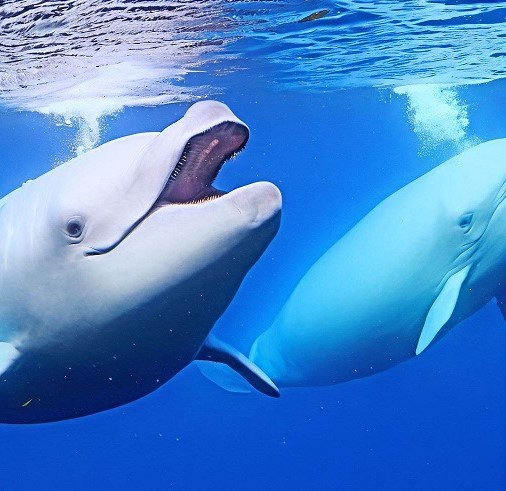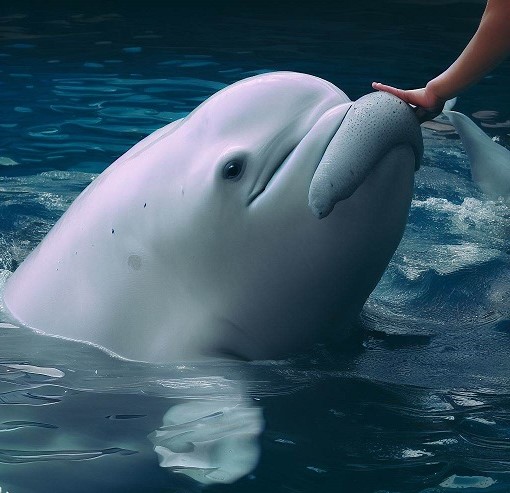Are Beluga Whales Dangerous? Discover The Truth
Are beluga whales dangerous? No, they’re friendly and sociable, often interacting with humans positively. They often allow people to gently touch them and may even playfully follow boats. Despite their size and strength, these gentle giants have no inclination to harm anyone.

They only show their teeth when they are scared or angry. Beluga whales eat fish and other sea animals, but they don’t think of humans as food. Beluga whales, also known as white whales, are smaller than blue whales, which are the largest animals on Earth, but both types of whales are important to the marine ecosystem.
So, even though they can be dangerous if they feel threatened, they are usually nice and curious towards humans.
Overview of Beluga Whales
Contents
- 1 Overview of Beluga Whales
- 2 Unique Characteristics
- 3 Are Beluga Whales Dangerous to Humans?
- 4 Can You Swim With Beluga Whales?
- 5 Can You Touch a Beluga Whale?
- 6 Why Are Beluga Whales So Friendly?
- 7 What Do Beluga Whales Eat?
- 8 Types of Beluga Whales
- 9 Are Any Whales Very Dangerous to People?
- 10 Conclusion
- 11 FAQs
“Are Beluga Whales Dangerous?” is a common inquiry, but in reality, these majestic marine mammals are generally not considered a threat to humans, as they are known for their gentle nature and friendly demeanor.
Beluga whales are amazing animals that can sing like birds. They have many special features that make them stand out among the whales. Here are some things you need to know about these wonderful creatures:
Size
Beluga whales are not very big compared to other whales. They are usually 13 to 20 feet long, and the males are a bit bigger than the females. They are still heavy though, weighing up to 3,500 pounds.
Habitat
Arctic and Subarctic Waters
Beluga whales live in the cold waters of the north. They swim in the Arctic Ocean and the seas around it, such as the Bering, Chukchi, and Beaufort Seas.
Coastal Habitats
Beluga whales like to go near the shore, where they can find rivers, bays, and estuaries. They go there more often in the summer when there is less ice and more food.
Unique Characteristics
Coloration
One of the most noticeable things about beluga whales is their white color. They have a thick layer of fat under their skin that keeps them warm and makes them white. This color may help them hide in the ice.
Melon
Beluga whales have a big, round head that is called a “melon.” They can change the shape of their melon by moving air around their nose. This helps them make different sounds and find their way with echolocation.
Teeth
Beluga whales have many small teeth that they use to catch their food. They like to eat fish, squid, and crustaceans.
Social Nature
Beluga whales are friendly and social animals. They travel in groups called pods, which can have a few or many members. The pods help them hunt together and stay safe from enemies.
Vocalization
Beluga whales are very noisy animals. They make all kinds of sounds, such as clicks, whistles, and chirps. They use these sounds to talk to each other, navigate, and find food. They are so vocal that they are sometimes called “sea canaries.”
Migrations
Some beluga whales stay in the same place all year round, but others move around a lot. For example, the belugas in Alaska have a long journey every year between their summer and winter homes. They travel hundreds of miles across the sea.
Beluga whales are interesting animals that have many unique traits and behaviors. They are important for the Arctic environment and for the people who study and admire them.
Are Beluga Whales Dangerous to Humans?

“Are Beluga Whales Dangerous to Humans? While beluga whales are generally known for their gentle nature, there have been rare instances of aggressive behavior, prompting scientists to investigate the question: Are Beluga Whales Dangerous in certain circumstances?”
They like to live in groups and have fun with humans. They are big and strong, but they don’t want to hurt anyone. They only show their teeth when they are scared or angry.
Beluga whales are very rare to see in the wild, and they are even rarer to attack humans. But you still need to be careful and respectful when you meet them.
You need to follow the rules and care about their health and happiness. This way, you can enjoy the amazing experience of seeing these beautiful white whales.
Can You Swim With Beluga Whales?
While the allure of swimming with beluga whales is captivating, many enthusiasts often inquire, “Are beluga whales dangerous?” before embarking on such an immersive experience.
These white whales are friendly and playful, and they love to meet humans. You can swim with them in some places, where they are used to people and happy to see them. But you need to be careful and respectful when you do that.
Some places have special tours and programs that can help you swim with beluga whales. They have guides who know how to protect these amazing animals. Swimming with beluga whales is a wonderful experience that you will never forget.
You can see how they act and communicate with each other. You can also learn more about why they need our help to save their home.
Can You Touch a Beluga Whale?
These whales are gentle and sociable, and they like to meet humans. You can touch them in some places, where they are well cared for and happy. These places have people who know how to protect these amazing animals.
While beluga whales are generally gentle and curious marine mammals, many people wonder, “Are beluga whales dangerous?” when considering whether it’s safe to touch them.
They help you touch the beluga whales safely and without stressing them out. Touching a beluga whale is a wonderful experience. You can feel their soft, slippery skin and see how they act and communicate with each other. But you need to be careful and respectful when you do that.
You need to follow the rules and care about their health and happiness. In the wild, you should not try to touch beluga whales. You might bother them or hurt their home.
Why Are Beluga Whales So Friendly?

Beluga whales are known for their friendly nature, often exhibiting sociable behavior with humans and other marine creatures, but it’s essential to address the common query “Are beluga whales dangerous?” to provide a comprehensive understanding of their behavior.
Beluga whales are amazing creatures that love to live and play together. They are very kind and curious, and they like to meet new friends. They are white whales that have a beautiful smile on their face. They like to live in groups and have fun with each other.
Beluga whales also love to meet humans and play with them. They don’t have many enemies in the cold Arctic, where they mostly live. Their friendliness helps them survive and work together to find food. But we need to be careful and respectful when we see these amazing white whales.
What Do Beluga Whales Eat?
Beluga whales are amazing creatures that live in the ocean and eat meat. They like to munch on different kinds of food, such as fish, squid, and shellfish. They can find food in different places, but they especially love the cold waters of the Arctic and subarctic regions.
There, they can feast on fish like cod, herring, capelin, and salmon. Beluga whales are smart and flexible hunters. They can work together with other whales or hunt by themselves. They can also eat different things depending on what is available. This helps them survive in their changing ocean homes.
Types of Beluga Whales
Beluga whales are all part of the same species, but they are not all the same. They have different groups or ecotypes that live in different places, have different genes, and act differently. Some of the most interesting ecotypes of beluga whales are:
Cook Inlet Belugas
These are the beluga whales that live in the Cook Inlet of Alaska. They travel a lot every year to find food and mates. They are very special and need our help because they are in danger of disappearing. The endangered Cook Inlet beluga whale population is currently estimated at 331 individuals.
Cumberland Sound Belugas
These are the beluga whales that live in the Cumberland Sound and nearby waters in the Canadian Arctic. They have a special way of living together and talking to each other. They make different sounds than other belugas.
Eastern Chukchi Sea Belugas
These are the beluga whales that live in the Chukchi Sea in the Arctic. They have adapted to their cold and icy home, and they have some different genes than other belugas.
St. Lawrence Estuary Belugas
These are the beluga whales that live in the St. Lawrence River. They stay there all year long, even when it gets very cold. They have a different way of organizing themselves and making friends.
Western Arctic Belugas
These are the beluga whales that live in the western Arctic region. They have a special way of moving around and finding their way. They have some different genes than other belugas.
Sakhalin-Amur Belugas
These are the beluga whales that live in the Sea of Okhotsk and the Sea of Japan. They move around a lot to follow their food and avoid predators. They also meet and mingle with other animals that live in the sea.
Beluga whales have different groups or ecotypes that are very special and interesting. They act differently, live in different places, and have different genes. This makes them very important for science and conservation.
Each of these ecotypes helps us learn more about beluga whales as a whole but also shows us why we need to protect them in different ways depending on where they live.
Are Any Whales Very Dangerous to People?
“Concerns about the potential danger of whales to humans often arise, prompting questions such as ‘Are Beluga Whales Dangerous?’ as people seek to understand the behavior and risks associated with these marine mammals.”
Whales are amazing animals that live in the ocean. Some whales are very big, like the orca, or killer whale. Sometimes, these whales can be angry and attack humans, especially when they are kept in small tanks. But this is very rare, and orcas in the wild are usually peaceful and don’t bother people. But you still need to be careful and respectful when you see whales, including orcas.
Conclusion
Are beluga whales dangerous? Beluga whales are amazing marine mammals that have a special mix of being friendly and dangerous. This shows how complex they are. They are very gentle and social, and they like to interact with humans in different ways.
They are also very curious and like to explore new things. But, we should not forget that they are also wild animals, and they can get angry or scared if we bother them or stress them out. This can make them act in ways that can hurt us or themselves.
That’s why we should always be careful and respectful when we meet them, and follow the rules and guidelines that protect them and us. By doing this, we can enjoy the wonderful friendliness of these beautiful creatures, and learn more about them and their natural homes.
FAQs
What is the average lifespan of a Beluga whale?
Beluga whales typically live between 35 to 50 years in the wild.
How do Beluga whales communicate?
Belugas use a variety of sounds, including clicks, whistles, and other vocalizations, for communication in their social groups.
What is the main diet of Beluga whales?
Belugas primarily feed on fish such as salmon, capelin, and cod, along with squid and crustaceans.
Where are Beluga whales found in the wild?
Belugas inhabit Arctic and subarctic waters, including the Arctic Ocean, the Sea of Okhotsk, and the St. Lawrence River.
Do Beluga whales migrate?
Yes, Beluga whales are known for their seasonal migration patterns, moving to warmer waters during the winter and returning to colder regions in the summer.












